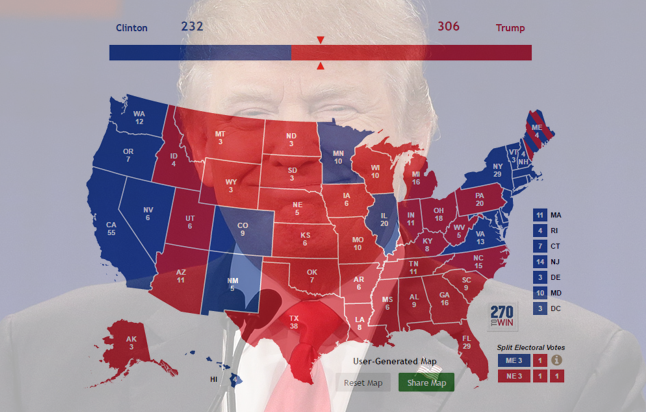A Closer Look at How Trump Pulled It Off
More stories from Gabe Geytsman
As the news media, the polling industry, and indeed all people across the globe are still reeling at the upset of the century that Donald Trump pulled off two days ago, some people are still providing explanations of the election results we all witnessed that stunned us all.
The most predominant factor that granted Trump the Presidency was his strength with college-uneducated white voters, especially in the Midwest, where they are the majority of voters. Trump and his campaign loyalists have long prophecied that his message on trade and immigration would appeal to these voters, noting that his message on trade and immigration would resound with them. They claimed that his message would bring these voters, which had been Democrats since Bill Clinton, the only Clinton to successfully run for President, won them over in the 90s, over to Trump, and they were right. They turned out in astonishing numbers for Donald Trump, and overall nationwide, Trump won college-uneducated white voters by a 39-point margin.
Trump was also carried by a lower black turnout. Whereas black voters were understandably excited for the Obama Presidency, for self-evident reasons, they were not particularly enthused by Hillary Clinton. Some attribute this to the tough-on-crime policies of her husband, and this, combined with general nationwide lack of enthusiasm for the Clinton candidacy, helped account for the drop in Clinton’s margins. For example, her margin in the county where the city of Flint is located in Michigan fell by some 13 points from Obama’s 2012 reelection.
The problem with predictive polling that assured Democrats and even persuaded Republicans of a Clinton win is that it does a lot of educated guessing. What I mean is that polls weight their results based on demographic composition of the area being surveyed, and weight their polls further by prior voter turnout statistics of those demographics; they also weight based on dubious likely voter criteria that likely excluded many first-time voters who were part of that college uneducated white bloc that went for Trump almost unanimously. So when pollsters look at high past turnout for the black demographics, when they look at low past turnout for certain white demographics, when they look at past voter history of people in Trump demographics, they end up weighting their polls completely incorrectly.
Significantly, pollsters were off in three states that Trump said for a long time he would win, Pennsylvania, Michigan, and Wisconsin. They were off by 4 points, 5 points, and as much as 8 points, respectively. They were also off in the Midwestern states of Ohio and Iowa, which Trump won by vastly larger margins that expected. These states share similar demographics, and, hence, the polling error was correlated across those Midwestern states.
It’s therefore interesting to examine polling in 2020, when pollsters will weight their polls based on turnout statistics from this election. Perhaps they might be much more pro-Trump the next time around. Because this election, they were much more pro-Clinton, seemingly overcorrecting for their error in 2012, when Obama overperformed his polls by 3%.
In general, it’s difficult for polling to adjudicate major shifts in the enthusiasm and turnout of certain key demographics in the electorate, as they failed to do this election cycle. Polling is predicated on the assumption that the constitution of the electorate will be the same as prior elections, which is why polling often is accurate. Don’t necessarily expect the polling industry to go out of business, or to be off again in the 2018 midterm elections.
To illustrate further the fact that polling fails to measure shifts in demographic enthusiasm (and, hence, turnout), Clinton overperformed her polls in Nevada, which has a high Latino population. She also did much, much better than President Obama in Arizona, a traditionally solid Republican state with a high Latino population. So while Trump energized many white voters to come his way, he also antagonized many Latino voters to come out against him. At the same time, Clinton failed to enthuse black voters. Clinton’s two trade-offs, then, were trading support among black voters for higher turnout among Hispanic voters, and trading support from blue collar whites to support from white collar whites. These two tradeoffs, however, were quite useless, because black voters are much more likely than Hispanics to be located in swing states. Fully one half of eligible Hispanic voters are located in Texas and California alone, which Trump and Clinton won by double digits, respectively.
But what many people in the media are neglecting to mention is that in addition to all of these factors, Trump outperformed Romney, the 2012 Republican nominee, among both Latino and black voters, winning about 28% and 8%, respectively, of those demographics, according to exit polling. He got above 30% of Hispanics in Florida, for example, which enabled him to win the state by a margin of just in excess of one percentage point. This did not help him, however, in Nevada, which both he and Romney failed to win.
At large, Trump was part of a movement which has been sweeping the West in the latter part of this decade, which is characterized by backlash of certain demographics, demarcated by both race and class, against what they see as a hostile establishment far too focused on the “net” gain of globalization and multiculturalism, at the expense of certain groups. Looking across the West, the polls similarly missed the victory of Brexit, which, like Trump, was 82% likely to lose, but ended up winning. Polling also underestimated a populist party in Sweden’s 2015 parliamentary elections by about 3 points. One would hope that pollsters would look up from their statistics books and observe the hemispheric shift in enthusiasm and poll accordingly. Trump tapped into what he rightfully called a movement, an earthquake, across Western countries, and was the right man at the right place at the right time. The people who were projecting a guaranteed Clinton victory, such as the Huffington Post or the New York Times, which gave her in excess of over a 90% chance of winning, didn’t learn from her narrow win in her primary against populist Bernie Sanders, who probably only lost because of superdelegates and crooked maneuverings of the Democratic National Committee.



